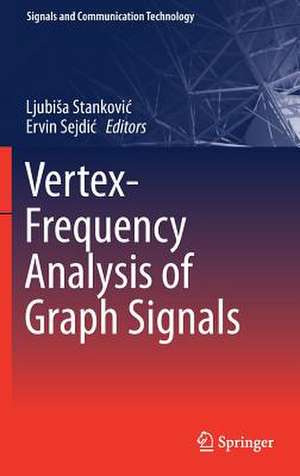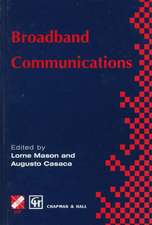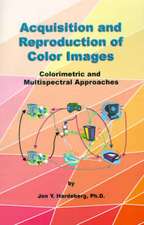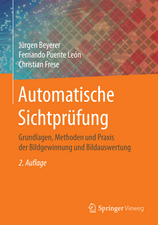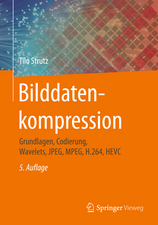Vertex-Frequency Analysis of Graph Signals: Signals and Communication Technology
Editat de Ljubiša Stanković, Ervin Sejdićen Limba Engleză Hardback – 14 dec 2018
Although signal processing techniques for the analysis of time-varying signals are well established, the corresponding graph signal processing equivalent approaches are still in their infancy. This book presents novel approaches to analyze vertex-varying graph signals. The vertex-frequency analysis methods use the Laplacian or adjacency matrix to establish connections between vertex and spectral (frequency) domain in order to analyze local signal behavior where edge connections are used for graph signal localization. The book applies combined concepts from time-frequency and wavelet analyses of classical signal processing to the analysis of graph signals.Covering analytical tools for vertex-varying applications, this book is of interest to researchers and practitioners in engineering, science, neuroscience, genome processing, just to name a few. It is also a valuable resource for postgraduate students and researchers looking to expand their knowledge of the vertex-frequency analysis theory and its applications. The book consists of 15 chapters contributed by 41 leading researches in the field.
Din seria Signals and Communication Technology
- 18%
 Preț: 952.89 lei
Preț: 952.89 lei - 18%
 Preț: 1559.80 lei
Preț: 1559.80 lei - 17%
 Preț: 361.80 lei
Preț: 361.80 lei - 18%
 Preț: 811.61 lei
Preț: 811.61 lei - 15%
 Preț: 585.26 lei
Preț: 585.26 lei - 18%
 Preț: 727.97 lei
Preț: 727.97 lei - 15%
 Preț: 585.90 lei
Preț: 585.90 lei -
 Preț: 393.35 lei
Preț: 393.35 lei - 20%
 Preț: 1002.73 lei
Preț: 1002.73 lei - 15%
 Preț: 641.71 lei
Preț: 641.71 lei - 20%
 Preț: 338.92 lei
Preț: 338.92 lei - 18%
 Preț: 1579.66 lei
Preț: 1579.66 lei - 18%
 Preț: 896.08 lei
Preț: 896.08 lei - 18%
 Preț: 847.11 lei
Preț: 847.11 lei - 18%
 Preț: 1234.77 lei
Preț: 1234.77 lei - 18%
 Preț: 905.54 lei
Preț: 905.54 lei - 15%
 Preț: 646.43 lei
Preț: 646.43 lei - 20%
 Preț: 662.48 lei
Preț: 662.48 lei - 15%
 Preț: 641.20 lei
Preț: 641.20 lei - 18%
 Preț: 1847.84 lei
Preț: 1847.84 lei - 18%
 Preț: 946.24 lei
Preț: 946.24 lei - 18%
 Preț: 1241.10 lei
Preț: 1241.10 lei - 20%
 Preț: 649.43 lei
Preț: 649.43 lei - 20%
 Preț: 993.28 lei
Preț: 993.28 lei - 18%
 Preț: 940.57 lei
Preț: 940.57 lei - 18%
 Preț: 1389.30 lei
Preț: 1389.30 lei - 20%
 Preț: 1003.50 lei
Preț: 1003.50 lei - 18%
 Preț: 953.52 lei
Preț: 953.52 lei - 20%
 Preț: 1001.16 lei
Preț: 1001.16 lei - 18%
 Preț: 1415.36 lei
Preț: 1415.36 lei - 15%
 Preț: 653.33 lei
Preț: 653.33 lei - 15%
 Preț: 645.60 lei
Preț: 645.60 lei - 15%
 Preț: 637.28 lei
Preț: 637.28 lei - 18%
 Preț: 948.79 lei
Preț: 948.79 lei - 18%
 Preț: 945.62 lei
Preț: 945.62 lei - 18%
 Preț: 836.36 lei
Preț: 836.36 lei - 18%
 Preț: 1225.46 lei
Preț: 1225.46 lei - 15%
 Preț: 635.01 lei
Preț: 635.01 lei - 15%
 Preț: 639.25 lei
Preț: 639.25 lei - 15%
 Preț: 646.30 lei
Preț: 646.30 lei - 15%
 Preț: 639.25 lei
Preț: 639.25 lei - 15%
 Preț: 712.36 lei
Preț: 712.36 lei - 20%
 Preț: 1006.12 lei
Preț: 1006.12 lei - 18%
 Preț: 970.56 lei
Preț: 970.56 lei
Preț: 1015.86 lei
Preț vechi: 1238.86 lei
-18% Nou
Puncte Express: 1524
Preț estimativ în valută:
194.41€ • 211.10$ • 163.30£
194.41€ • 211.10$ • 163.30£
Carte tipărită la comandă
Livrare economică 22 aprilie-06 mai
Preluare comenzi: 021 569.72.76
Specificații
ISBN-13: 9783030035730
ISBN-10: 3030035735
Pagini: 499
Ilustrații: XV, 507 p. 196 illus., 170 illus. in color.
Dimensiuni: 155 x 235 mm
Greutate: 0.9 kg
Ediția:1st ed. 2019
Editura: Springer International Publishing
Colecția Springer
Seria Signals and Communication Technology
Locul publicării:Cham, Switzerland
ISBN-10: 3030035735
Pagini: 499
Ilustrații: XV, 507 p. 196 illus., 170 illus. in color.
Dimensiuni: 155 x 235 mm
Greutate: 0.9 kg
Ediția:1st ed. 2019
Editura: Springer International Publishing
Colecția Springer
Seria Signals and Communication Technology
Locul publicării:Cham, Switzerland
Cuprins
Introduction to Graph Signal Processing.- Oversampled Graph Laplacian Matrix for Graph Filter Banks.- Toward an Uncertainty Principle for Weighted Graphs.- Graph Theoretic Uncertainty and Feasibility.- Signal-Adapted Tight Frames on Graphs.- Local Spectral Analysis of the Cerebral Cortex: New Gyrification Indices.- Intrinsic Geometric Information Transfer Learning on Multiple Graph-Structured Datasets.
Notă biografică
Ljubiša Stankovic received the B.S.and the Ph.D degree in Electrical Engineering from the University of Montenegro, and the M.S. degree from the University of Belgrade. He is a professor at the University of Montenegro. He has been visiting academic at several universities, including the Ruhr University Bochum, Technische Universiteit Eindhoven, and the Imperial College, London. He is a member and vice-president of the National Academy of Science and Arts of Montenegro and a member of the European Academy of Sciences and Arts. He is a senior area editor of the IEEE Transactions on Image Processing, a member of the Editorial Board of Signal Processing, and an associate editor of the IET Signal Processing. He was an associate editor of the IEEE Signal Processing Letters and the IEEE Transactions on Signal Processing. His current interests are in Signal Processing. He published several books and about 400 papers, more than 150 of them in the leading journals. He was awarded the best Signal Processing journal award in 2017 by the European Association for Signal Processing. Stankovic is a Fellow of the IEEE since 2012 for contributors to time-frequency signal analysis.
Ervin Sejdic received the B.E.Sc. and Ph.D. degrees in electrical engineering from the University of Western Ontario, London, ON, Canada, in 2002 and 2008, respectively. He was a Postdoctoral Fellow with Holland Bloorview Kids Rehabilitation Hospital/University of Toronto and a Research Fellow in medicine with Beth Israel Deaconess Medical Center/Harvard Medical School. He is currently an Associate Professor with the Department of Electrical and Computer Engineering (Swanson School of Engineering), the Department of Bioengineering (Swanson School of Engineering), the Department of Biomedical Informatics (School of Medicine), and the Intelligent Systems Program (School of Computing andInformation) at the University of Pittsburgh, Pittsburgh, PA, USA. His research interests include biomedical and theoretical signal processing, swallowing difficulties, gait and balance, assistive technologies, rehabilitation engineering, anticipatory medical devices, and advanced information systems in medicine.
Ervin Sejdic received the B.E.Sc. and Ph.D. degrees in electrical engineering from the University of Western Ontario, London, ON, Canada, in 2002 and 2008, respectively. He was a Postdoctoral Fellow with Holland Bloorview Kids Rehabilitation Hospital/University of Toronto and a Research Fellow in medicine with Beth Israel Deaconess Medical Center/Harvard Medical School. He is currently an Associate Professor with the Department of Electrical and Computer Engineering (Swanson School of Engineering), the Department of Bioengineering (Swanson School of Engineering), the Department of Biomedical Informatics (School of Medicine), and the Intelligent Systems Program (School of Computing andInformation) at the University of Pittsburgh, Pittsburgh, PA, USA. His research interests include biomedical and theoretical signal processing, swallowing difficulties, gait and balance, assistive technologies, rehabilitation engineering, anticipatory medical devices, and advanced information systems in medicine.
Textul de pe ultima copertă
This book introduces new methods to analyze vertex-varying graph signals. In many real-world scenarios, the data sensing domain is not a regular grid, but a more complex network that consists of sensing points (vertices) and edges (relating the sensing points). Furthermore, sensing geometry or signal properties define the relation among sensed signal points. Even for the data sensed in the well-defined time or space domain, the introduction of new relationships among the sensing points may produce new insights in the analysis and result in more advanced data processing techniques. The data domain, in these cases and discussed in this book, is defined by a graph. Graphs exploit the fundamental relations among the data points. Processing of signals whose sensing domains are defined by graphs resulted in graph data processing as an emerging field in signal processing.
Although signal processing techniques for the analysis of time-varying signals are well established, the corresponding graph signal processing equivalent approaches are still in their infancy. This book presents novel approaches to analyze vertex-varying graph signals. The vertex-frequency analysis methods use the Laplacian or adjacency matrix to establish connections between vertex and spectral (frequency) domain in order to analyze local signal behavior where edge connections are used for graph signal localization. The book applies combined concepts from time-frequency and wavelet analyses of classical signal processing to the analysis of graph signals.
Covering analytical tools for vertex-varying applications, this book is of interest to researchers and practitioners in engineering, science, neuroscience, genome processing, just to name a few. It is also a valuable resource for postgraduate students and researchers looking to expand their knowledge of the vertex-frequency analysis theory and its applications. The book consists of 15 chapters contributed by 41 leading researches in the field.
Although signal processing techniques for the analysis of time-varying signals are well established, the corresponding graph signal processing equivalent approaches are still in their infancy. This book presents novel approaches to analyze vertex-varying graph signals. The vertex-frequency analysis methods use the Laplacian or adjacency matrix to establish connections between vertex and spectral (frequency) domain in order to analyze local signal behavior where edge connections are used for graph signal localization. The book applies combined concepts from time-frequency and wavelet analyses of classical signal processing to the analysis of graph signals.
Covering analytical tools for vertex-varying applications, this book is of interest to researchers and practitioners in engineering, science, neuroscience, genome processing, just to name a few. It is also a valuable resource for postgraduate students and researchers looking to expand their knowledge of the vertex-frequency analysis theory and its applications. The book consists of 15 chapters contributed by 41 leading researches in the field.
Caracteristici
Introduces graph signal processing Provides novel algorithms that can be used to analyse vertex-varying graph signals Explains how these new methods can be applied to increase our understanding of the human brain, social networks, and genomics
